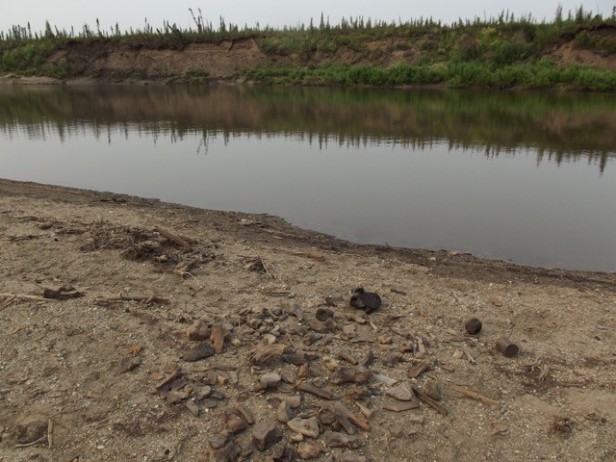The Old Crow River in northern Yukon is an area significant for its Pleistocene fossils. During the ice age (2.6 million to 10,000 years ago), it formed part of the Beringian Refugium, an arid, glacier-free area that attracted many animals—both extant and extinct—whenever surrounding regions were ice-covered.
For much of the year, the Old Crow River is a deeply meandering, almost bucolic river. It flows from eastern Alaska, heading southeast along the edge of Vuntut National Park and down to the village of Old Crow where it joins the Porcupine River.
But in the spring, the water level rises considerably. As a result, for thousands of years the fossil fragments buried on the bottom and along the banks have been continually picked up and redeposited, often ending up along the river’s many point bars (depositional areas on the inside bends of meandering rivers).
The most fossil-rich point bar is a site referred to as ‘Harington’s Loc. 11A’, named after the Canadian Museum of Nature’s palaeontologist (emeritus) Dr. C.R. Harington. Along with archaeologist William Irving (of the former National Museum of Man, Ottawa), Dr. Harington has been one of the principal collectors on the Old Crow River, adding thousands of its fossils to our CMN palaeontology collections.

In July 2019, I was invited by Dr. Grant Zazula and his associate Elizabeth Hall to accompany them and their two field assistants (from the Vuntut Gwitchin village of Old Crow), to the Loc. 11A point bar for a week of fossil prospecting.

From the village of Old Crow, we were flown by helicopter to Loc. 11A where we set up camp for the week. Over the next several days, when we weren’t collecting at 11A, we made boat trips up and down the river to other sites that Dr. Harington had documented.

At the end of the week, the many, many bags of sorted bones we collected were flown back to Old Crow village. In accordance with the 1993 land claims and self-government agreements, the Gwitchin peoples are entitled to the ownership and management of all fossils and artifacts collected from their land since 1995.

I would like to thank Dr. Zazula for inviting me to take part in his fieldwork. After my 20 years of caring for the roughly 20,000 Old Crow fossil fragments currently housed in the Canadian Museum of Nature, it gave me the opportunity to experience firsthand the environment in which they were, and still are, being discovered.
The author would also like to thank the Canadian Museum of Nature’s Centre for Arctic Knowledge and Exploration, which partially covered transportation costs for this fieldwork, as well as Dr. Danielle Fraser, the museum’s mammal palaeontologist, for her generosity in offering part of her Arctic field work budget to cover the balance.
